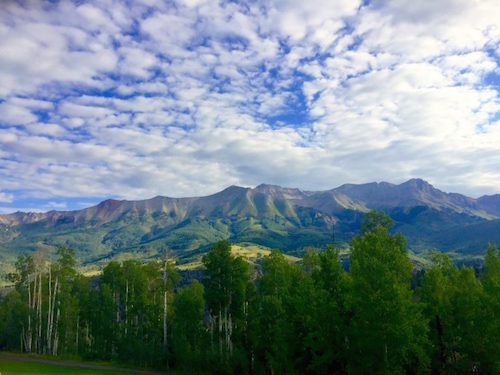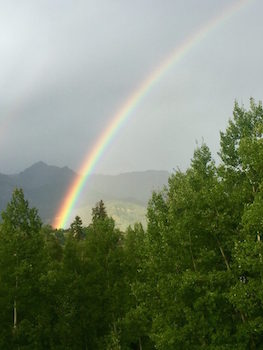On Honest Art
This article was originally published on The Washington Institute for Faith, Vocation & Culture blog.

Almost as pretty as it gets . . . and yet.
Telluride is also a place like every place. The sun rises, the day unfolds, the evening comes. People work and worship, they play outdoors and cry indoors, they eat and drink, they play music and watch movies. In and through it all they, like every one of us, are thinking through the world, knowing two things to be true at the same time: what they see and hear is so very wonderful, and it is so very wounded too. Some things are just about as good as it gets, and some things are just not what it’s supposed to be. In our very bones, we feel both, all day, every day. Knowing that that is true, what do we do?
That was the question of the day, and of the days together for the first-ever retreat of Art House America, a collective of three places in three cities—Nashville, Dallas, and St. Paul. The principals for all three Art Houses met in the mountains of Telluride, in awe of the unusual beauty of the San Juans of southwestern Colorado, and yet by our very humanity attentive to the complexity of a world that is both beautiful and broken, a tension we know so well, we know too intimately, we know very personally.
How is it possible to hold them together? The glory and the ruin? The grandeur and the groaning? Can we? Should we? Is it possible to even try?
Over the course of several days we talked together about the book Visions of Vocation, especially its central question, “Can we know the world and still love it?” Keeping the eyes of our hearts wide open to the complexity of life, can we still see ourselves implicated, for love’s sake, in the way the world turns out? For a day we considered our deepest disposition, sons of Adam and daughters of Eve that we are: we compartmentalize, we believe one thing to be true and behave as if another thing is true, we say “This matters most!” and then live as if it doesn’t really. This tendency has profound implications, for learning, for labor, for love, for liturgy—for all of who we are, for all of how we live.
How do we begin to find our way to coherence? Can we even imagine a way of seeing and hearing that honestly connects what we believe with the way that we live? And because these were artists, we talked about artists. Novelists and poets, singers and songwriters, painters and playwrights, dancers and filmmakers too—each in his or her own way people who have struggled through the tension, finding their own clay-footed ways to hold onto both wonder and wound in the very way they do their work, like P. D. James and Walker Percy, U2 and Mumford and Sons, the BBC’s Call the Midwife and the Slovakian cellist Jozef Luptak.
But we also spent a morning talking about a long-ago conversation I had with a musician. Not my daily work, but sometimes along the way I have done that, hoping for an honest conversation about things that matter. Before a concert for thousands, a few of us sat behind the stage, attended by the traveling chef who made meals for the artists’ delight—and we had an hour before the traveling masseuse would come calling for the pre-concert massage. Because this musician was deeply taken by the dilemma of human rights abuses all over the world, and had chosen to use his own money to buy video cameras for aid and development workers to film wrongs as they happened, we wondered if he needed any help? That was our conversation.
But before it finished, we pressed more deeply into the whys of his passion. What had made him care? That is always a question, and answer, that I am drawn to. A Brit, he described himself as a “worn-out Westerner,” someone who had lived his life amidst the ruins of the Enlightenment world, a world without windows to transcendence, and he longed for more—so he finally became a Buddhist. I listened, thinking about my life, full as it is has been of conversations with people all over the world who believe all kinds of things about the world. And yes, along the way, reading Buddhism and talking with Buddhists.
At a certain point I asked a question—and he called off his massage, saying that he wanted to keep talking. I acknowledged the appeal of the East, of its seeming stillness in a very busy and broken world, telling him that I understood enough to understand why that drew him. And I commended his commitment, seeing that his humanity demanded that he care. But then I went deeper, asking him about the intellectual coherence of Buddhism—poignantly, its disconnect between the professed harmony of all things and the deep disharmony at its foundations. If in fact the final enlightenment promised by Buddhism allows us to see that everything is illusion because everything is one, it is necessarily a denial of distinctions, of every apparent distinction. Good and evil, truth and lie, justice and injustice. All these are illusions. Why then would we protest human rights abuses in Cambodia? In what world are they wrong?
In my own way I was asking for coherence between the metaphysical foundation of Buddhism and its moral appeal. How can we hold in our hearts our deepest beliefs about life and the world alongside our awareness of the way we live in the world—especially the stories we tell and the songs we sing about that world.
Can our art honestly reflect that tension? As we talked about this, there were tears. The questions are not easy, nor are the answers. Finding coherence in our callings is not for the faint-hearted. But if we are going to be people who keep at it, who keep on keeping on, finding new ways to see and hear the world—as movie-makers and musicians whose work is seen and heard the world over—then we have to keep our integrity, holding hope and heartache together, sometimes crying out into the cosmos as we do.

Yes, all that and more.
But as serious a question as that is, this was a retreat after all—and so we laughed too, of course, we laughed and laughed, eating and playing and fishing to our heart’s content, taking the mountain majesty into our deepest places.
I made no final criticism of the musician. He was trying, and I honored that. But at the end of the day the challenge is to become a more seamless human being, one whose beliefs about the world make some honest sense of the world, one who laughs and cries about reality, about the world we really live in, understanding that the best stories and songs tell the truth about the human condition, artfully weaving both joy and sorrow into our ordinary lives in our ordinary places—sometimes even into the town of Telluride.
Simply said, the best of the Art House is its commitment to that kind of art, to an honest art, to an art that doesn’t flinch at either the glory or the ruin of being human. Nothing less than that is wanted, nothing less than that is needed.
For more on Art House America, see these articles:



















